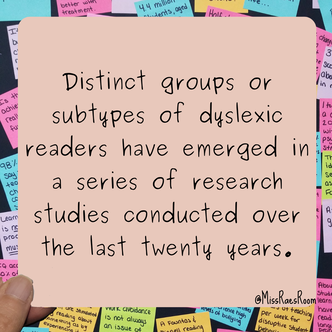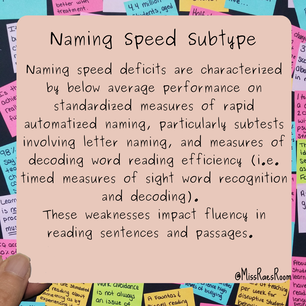Discover Miss Rae's Room Dyslexia Blogs, a comprehensive series dedicated to empowering educators and promoting effective strategies for students with Dyslexia. From different types of Dyslexia and Dyslexia screeners to signs of Dyslexia and evidence-based interventions and accommodations in the general education classroom, explore the infusion of the Science of Reading into instruction, explore school's roles in defining Dyslexia, and learn about best practices for teaching students with Dyslexia. Gain valuable insights and practical guidance to create inclusive and supportive learning environments. Start your journey towards improving outcomes for students with Dyslexia today!
|
11/17/2022 5 Comments Are There Different Types of Dyslexia?
So, what exactly is Dyslexia?
Well, let's start with the most widely accepted definition created in 2002 by the National Institute Of Child Health and Development: "Dyslexia is a specific learning disability that is neurobiological in origin. It is characterized by difficulties with accurate and/or fluent word recognition and by poor spelling and decoding abilities. These difficulties typically result from a deficit in the phonological component of language that is often unexpected in relation to other cognitive abilities and the provision of effective classroom instruction. Secondary consequences may include problems in reading comprehension and reduced reading experience that can impede growth of vocabulary and background knowledge."
So, now that we have the formalities out of the way - let's unpack that!
Dyslexia is an unexpected difficulty in reading. What I mean by unexpected is that Dyslexia is unexpected in relation to the student's cognitive ability, motivation, and exposure to reasonably effective reading instruction. It is highly hereditary in nature. Research actually shows us that there is a 50% chance of diagnosis when a parent or sibling has it. The core weakness in Dyslexia is related to students' accurate and efficient pairing between the sounds in words (phonological processing) and their corresponding letter or letter patterns. This often results in lagging skills in sight word recognition, decoding, overall reading fluency, and can also impact spelling. And then as a result of word reading difficulties, students with dyslexia are exposed to a significantly smaller volume of expository and narrative texts, thereby limiting their development of vocabulary and background knowledge. This is referred to as the Matthew Effect. Students with Dyslexia can also have lagging skills in spoken language and struggle to express themselves clearly or comprehend what others mean when they speak. So now that you know what Dyslexia is, did you know that there are subtypes of Dyslexia?
Distinct groups or subtypes of Dyslexic readers have emerged in a series of research studies conducted over the last twenty years. So researchers have attempted to group commonly observed behaviors into different categories.
The most common subtypes include a Phonological Deficit and a Naming Speed Deficit.
The phonological subtype impacts phonological awareness and decoding, sight word and passage accuracy. This subtype is characterized as below average performance on standardized measures of phonemic awareness and assessments of decoding, sight word and/or passage accuracy. These weaknesses impact accuracy of reading single words and connected text.
The Naming Speed Subtype impacts Rapid Automatized Naming, Decoding Efficiency, Sight Word Efficiency, and Passage Fluency. Naming speed deficits are characterized by below average performance on standardized measures of rapid automatized naming, particularly subtests involving letter naming, and measures of decoding word reading efficiency (i.e. timed measures of sight word recognition and decoding). These weaknesses impact fluency in reading sentences and passages.
The combination of both deficits in some students results in a reading impairment that is more severe than in students with a single deficit. The Double Deficit Subtype includes impairments in both phonological and naming speed subtypes. Students with a double deficit demonstrate below average performance in both areas. These weaknesses impact accuracy of reading single words and connected text and fluency in reading sentences and passages.
Regardless of the subtype, Dyslexia is a neurological disability, but the exact cause is still unclear. Despite this, brain imaging shows differences in the way a Dyslexic brain develops and functions. Specifically, Dyslexic brains have been found to have difficulties in identifying separate speech sounds within a word and/or learning how letters represent those sounds
Dyslexia is not the result of the daily struggle of learning to read, but rather the result of a unique neurological profile. And as a result, the impact of Dyslexia is different for each person. We used to think it was more visual in nature, meaning that the disability could be seen in things like letter reversals, seeing or reading words backwards, or letter confusions, but... Research now shows us that it is not a visual disability, but rather, it is a language-based disability. The "visual" issues that we observe are actually indicative of difficulties with recalling letter symbols for sounds and letter patterns in words. Happy & Healthy Teaching! PEACE, Miss Rae Learn more by following me on Instagram!Related Resources...
References:
Brady, Susan. 2019. “The 2003 IDA definition of dyslexia: A call for changes.†Perspectives on Language and Literacy 45, no. 1: 15-21. Keys to Literacy, Understanding Dyslexia, course Kilpatrick, David A. "Essentials of assessing, preventing, and overcoming reading difficulties." Hoboken, New Jersey : Wiley, 2015. Shaywitz, Sally E., and Bennett A. Shaywitz. 2020. Overcoming Dyslexia: Second Edition, Completely Revised and Updated. New York: Knopf Doubleday Publishing Group.
5 Comments
Pamela Hinton
11/19/2022 11:15:13 am
Would you please cite the research that you are referencing?
Reply
Pamela Hinton
12/3/2022 10:41:35 am
Thank you so much! 11/10/2023 09:54:05 am
Wow, I had no idea that dyslexia is a disorder that could affect a person's ability to focus. It does make sense to consider treating this to improve their ability to absorb new things. I think children and students with dyslexia should try receiving private tutoring sessions for subjects that they struggle with.
Reply
Hi! I am thrilled to read my blog was enlightening! Some students with Dyslexia also have Attention-Deficit Hyperactivity Disorder (ADHD), dysgraphia, dyscalculia, speech/language disorders, executive functioning disorder, and/or anxiety. It's actually not uncommon for somebody who has Dyslexia to have some other neurodiversities or learning and emotional challenges too. We call these co-occurring conditions. For example, ADHD is the most common comorbidity with Dyslexia. Therefore, while Dyslexia does not cause co-morbidities, it is important to be mindful of these co-occurences. Happy Teaching! Miss Rae
Reply
Your comment will be posted after it is approved.
Leave a Reply. |
Proudly powered by Weebly











 RSS Feed
RSS Feed